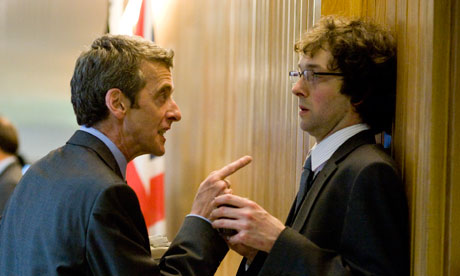Admittedly, it's an impossible question for a person like me who views, on average about 200 movies per year, but people (students especially) ask nonetheless, "What's your favorite movie?"
The questioner should understand that she is not asking, "What do you think is the best movie--worthiest movie--most artful movie..." Presumably the question invites discussion of a guilty pleasure. And the fact is, I cling to my bosom a lot of movies that are not very good as movies. The W.C. Fields vehicle
It's A Gift is virtually a working manual of crudeness of technique.
The Producers barely makes any sense and the last ten minutes or so of the film completely collapse. There's scarcely a musical made that really holds up under serious scrutiny, so they're all out, as are Jackie Chan films.
So perhaps my choice is a bit weasel-y, because it is an Official Recognized Classic. But once one considers the complete and utter destruction of human life due to male pride and vanity, what other response is possible, but laughter? So
Dr. Strangelove is, theoretically, that most perfect of comedies--one that makes you laugh to (and at) death.
Any sane person laughs at that movie, then goes home, or upstairs to bed and has the night terrors (my personal definition of a perfect comedy). For that reason, although there has been much scathing satire in the ensuing 46 years since
Strangelove's release, few have attempted that kind of large-scale gallows humor.
Thus,
In The Loop (2009) sneaks in the side door of catastrophic satire. Presidents, Prime Ministers and Premiers are banned from the landscape, and our gaze is not permitted to go any higher than the sight of cabinet officers, their minions and enforcers. (In fact, the film suggests that critical policy is set without the knowledge or consent of elected officials.) The story, in a nutshell, is that of Britain being dragged into an American incursion in the Middle East primarily due to the thoughtless words of a thoughtless Cabinet Minister.
The film employs the faux-documentary modus best known here from
The Office. The value of the technique is to convey the idea that one is hearing things one is Not Supposed To Hear. Interestingly,
Strangelove uses some of the same techniques--the attack on the quarantined air base is shot with hand held grainy footage that must have looked very rough in its time. The War Room appears to have been shot with available light (obviously, the light is actually designed, most probably by the DP, Gilbert Taylor, but it appears to make no concessions to the movie camera, as it is alternately flat and harsh. It all lends an air of reality to some rather baroque performances and dialogue. (Although Peter Sellers's rendition of President Muffley's phone call to Premier Kissoff is a model of precisely observed acting.)
In The Loop even echoes Strangelove's immortal line, "There is no fighting in the war room" with a tense negotiation taking place in the meditation room at the UN. This setting is evidently based on fact as told to the writers of the film. According to the director, at the end of a screening of
In The Loop to a group of Washington insiders, one of them raised his hand and said, "Can we just say we're sorry?"
Watch it and laugh--if you can handle the truth.






No comments:
Post a Comment